Motivation as a tool in employee's performance in total
Every outfit with a propensity for growth and advancement knows the importance of motivating their staff. Employee motivation has been established as one key factor for maximizing the performance of workers and enhancing their productivity (Ekundayo, 2018, Waiyaki, 2017; Tršková, 2016; Robescu Iancu, 2016; Richard, 2014; Kian Yusoff, 2014; Muogbo, 2013). Thus, many organizations have examined this construct in relation to the performance output of their employees (Mohamud, Ibrahim, & Hussein, (2017; Nduka, 2016). Employee motivation is a measure of what drives an employee and enhances his productivity. It refers to those factors both internal and external to the employee that can trigger his morale and boosting his output. It is what drives the employee to try to do more, operate at his maximum capacity and produce outstanding results which would normally not be so in the absence of the motivating factor(s). The heterogeneity of the human needs has led to a lot of factors being isolated as motivational. Some of the factors are inherent in the person’s personality while others are external to the person. Whether these motivational factors are intrinsic or extrinsic, the underlying fact remains that there is a basic need in the person crying out to be met. These needs drive the individual to seek some form of satisfaction. Thus, where there lies the propensity of needs being met, he individual gets motivated to achieve, to attain some basic goals in view.This paper will therefore on those factors that are externally driven or controlled that can boost the employee’s performance. Among the various tools that are organizational driven that are capable of motivating employees are promotion, compensation, pay raises and recognition.
Statement of the problem
Employers of labor and management of organizations are aware that employees’ efforts and commitment to organizational goals in terms of their performance are the prerequisites for any organization thriving. Thus, various works have been done in different disciplines in order to understand the entity called a human being and the factors that drive him (Penney, David & Witt, 2011). Organizational leaders and management teams are interested in inspiring their workers to maximum level of work performance because of the benefits that accrue to the organization from such endeavors. Several researches have established a proportional relationship between motivation and performance (Ekundayo, 2018; Olawumi, 2013; Obikeze, 2012) in organizations and elsewhere (Bao & Nizam, 2015; Kian & Yusoff, 2014; Dobre, 2013; Ayam, Kusi-Appiah, Nyamekye, Kyei-Addae, & Amoah, 2012). Motivation being a complexity of psychological factors has been researched more than any other known factor in organizations. A lot of researches have been focused on intrinsic and extrinsic motivations (Ekundayo, 2018; Olawumi, 2013; Obikeze, 2012) in organizations and elsewhere (Bao & Nizam, 2015; Kian & Yusoff, 2014; Dobre, 2013; Ayam et al., 2012). A lot of these works have related motivation with performance. Empirical literature has also established significant relationships/effects between motivation and performance using different motivational factors in different profit making and non-profit making organizations in different parts of the world (Amoatemaa, & Kyeremeh, 2016; Aamir, Jehanzeb, Rasheed & Malik, 2012; Eshun & Duah, 2011). Thus, it is from this premise the researcher decidedly took the impetus to conduct a research in Total Nigeria Ltd. to ascertain if the motivational tools used by the company had effects on the performance of the employees.
Objectives of the study
The more specific objectives of the study were to;
1. examine the effect of promotion on the performance of employees of Total Nig. Ltd.
2. examine the effect of recognition on the performance of employees of Total Nig. Ltd.
3. ascertain the effect of pay raise on the performance of employees of Total Nig. Ltd.
4. ascertain the effect of compensation on the performance of employees of Total Nig. Ltd.
Research questions
1. What is the effect of promotion on the performance of employees of Total Nig. Ltd.?
2. What is the effect of recognition on the performance of employees of Total Nig. Ltd?
3. What is the effect of pay raise on the performance of employees of Total Nig. Ltd.?
4. What is the effect of compensation on the performance of employees of Total Nig. Ltd.?
Research hypotheses
1. There is no significant effect of promotion on the performance of employees of Total Nig. Ltd.
2. There is no significant effect of recognition on the performance of employees of Total Nig. Ltd.
3. There is no significant effects of pay raise on the performance of employees of Total Nig. Ltd.
4. There is no significant effect of compensation on the performance of employees of Total Nig. Ltd.
Scope of the study
This study focused on the regular staff of Total Nigeria Limited. The researcher treated motivational factors with special bias on promotion, recognition, pay raise and compensation as used by Total Nig. Ltd., and their effects on performance with effectiveness (i.e. ability to meet targets and get assign jobs done) as the proxy.
1. REVIEW OF RELATED LITERAURE
Review of theoretical literature
This seminar paper analyses two theories that are related to motivation and performance. These theories are the Herzberg Motivation/Hygiene theory and the Expectancy theory. The Herzberg Motivation/Hygiene Theory The Motivation/Hygiene theory also known as the two-factor theory is credited to Frederick Herzberg who propounded this theory in the mid-20 th century to explain and relate the performance/satisfaction of employees to motivation. The two factors in his theory are the motivating factors known as motivators/satisfiers and the demotivating factors known as hygiene factors/dissatisfiers (Haque, Haque, & Islam, 2014). Herzberg didn’t see these two factors as opposites but explained that satisfiers were actually those factors that could motivate employees and make them happy to work harder like intrinsic feelings and opportunities for learning, recognition, advancement, growth, more responsibility, etc., while hygiene factors such as company policies, quality of supervision, rate of pay, job security, working conditions, etc., though not motivators, needed to be present to sustain employees’ satisfaction in their jobs. Herzberg opined that the absence of hygiene factors would cause dissatisfaction even in the presence of motivators.
The Expectancy Theory
The expectancy theory, also known as the instrumentality theory or valence-instrumentality-expectancy theory (VIE) or the path-goal was popularized by Victor H. Vroom in 1969. The main point of this theory is that employees have certain expectations that the labor or efforts they put into their task must yield a commensurate level of reward which will motivate them to aim for the desired results. When management acts to meet their expectations, they become motivated. Vroom developed three variables which are expectancy, valence and instrumentality. Employees who expect to achieve particular results and have very strong needs for some intrinsic and extrinsic rewards get motivated when their efforts are duly rewarded. This theory lends its value in the fact that employees would put in their best to achieve desired results as significant motivational force from the interaction of these variables exude from them (Haque, Haque, & Islam, 2014).
Review of conceptual literature
Employee Motivation
Shahzadi, Javed, Pirzada, Nasreen, & Khanam (2014), in their definition of performance stated that it is “a reflection of the level of energy, commitment, and creativity that a company's workers bring to their jobs.” Apparently, no single human being can accomplish all his goals without the inputs of other like-minded individuals. Managers on their own cannot achieve organizational goals. They need the contributions of others to get things done. It therefore becomes the task of the manager to adequately motivate his staff, enough to get them to perform at the maximum point that can trigger and activate the actualization of organizational objectives.
According to Mile (2004) cited in Ekundayo, (2018), conditions that influence “the arousal, direction and maintenance of behavior” constitute motivation. Ekundayo (2018) has cited Kreitner (1989) and Higgins (1994) as positing that motivation comprise the psychological process that equips a person’s behavior with the vigor, purpose, passion and direction to want to satisfy a need. Researchers have examined this concept in relation to financial and non-financial incentives each emphasizing the relevant effect on performance. There is no agreement among scholars on which tool motivates a worker more (Mathias and Jackson, 2008). Total Nig. Ltd. motivates its staff using promotion, recognition, pay raise and compensation. For promotion and pay raise, the percentage increment is done based on percentage or category of achievement from the results of their staff performance appraisal. Normally, results are classified as “Top; Upper middle; Middle; Lower Middle; and Fairly satisfactory”.
Promotion as a motivational tool
Promotion is a form of reward that involves moving an employee from one position to a higher one in the hierarchy of an organization or an actual upward change in employees’ status within an organization (Roszyk-Kowalska & Duda, 2017; Yusof & Tan, 2015). It is the advancement of positions of employees in an organization. They emphasize its importance and effectiveness in motivating employees. Accordingly, Jane, Mike, & Namusonge (2012), opine that promotion, besides enhancing the self-assessment of an employee, serves to satisfy their need for recognition, achievement and advancement, as employees seek to work in jobs that provide opportunities for growth and challenges.
Among the many benefits of promotion are its ability to increase employees’ zeal and passion, enhance performance and individual self-concept. But for promotion to achieve its aim, it must be fair and deem commensurate with the efforts of the employees (Roszyk-Kowalska & Duda, 2017). A well- deserved promotion encourages and challenges both the promoted employee(s) and others while an unjust promotion deters efforts, discourages committed employees, strains relationships within the organization and increases turn over intentions/rate (Roszyk-Kowalska & Duda (2017; Jane, Mike, & Namusonge, 2012). Total Nigeria Ltd carries out its staff promotional activities based on the results of appraisal which are tied to key performance indicators given to employees.
Recognition as a motivational tool
Harrison (2005) defines recognition as “the timely, informal and/or formal acknowledgement of a person’s behavior, effort or business result that supports the organization’s goals and values, and which clearly has been beyond normal expectations”. Recognition is an expression of management appreciation and acknowledgement of employees’ performance, personal dedication and engagement at all times (Nyakundi, Karanja, Charles & Bisobori, 2012). Brun and Dugas (2008), identified key areas for recognition as personal recognition, employee work practice, employee job dedication and results. By giving recognition, management confers on the recognized employees a sense of belonging and boost their morale, loyalty and retention rate (Imran, Ahmad, Nisar & Ahmad, 2014; Danish & Usman, 2010; Brun & Dugas, 2008; Luthans, 2000). Recognition takes several forms such as; notes of appreciation; verbal thank you; periodic public award of certificates/trophies; shopping vouchers; theatre tickets; reserved parking space; dinner; domestic goods and use of some facilities (Grote, 2006; Nolan, 2012; Luthans, 2000).
Pay raise as a motivational tool
A worker is entitled to some form of financial reward for their labor. This reward could be in the forms of wages (hourly payment), salary (monthly payment) or piece rate (payment based on number of items produced within a specified period). Pay raises comprise increase in wage or salary, bonus payments or commission and monetary incentives. Although Lindner (1998), sees monetary incentives as having little value, it is on record that many organizations use it as a way of motivating their employees. (Ude, & Coker, 2012; Eshun & Duah, 2011). Stajkovic and Luthans (2003) have observed that money is a strong basis for meeting people’s needs through the purchasing power it offers. According to these scholars, these payments increase both speed and production level of employees. More so, employees get more motivated when they are granted pay raises periodically either as promotion benefits, length of service to the organization or special recognition of outstanding performance (Cole 1998; Chien-Chung, 2003).
Compensation as a motivational tool
Compensation refers to all forms of reward granted to employees in return for the services they render to the organization (Aamir et al., 2012; Perry, Mesch and Paarlberg, 2006). Scholars note that compensation could be offered as direct payments which take the form of pay raises, bonuses, incentives and commission or indirect payment which include grants, health insurance, pension benefits paid by the employer, free meals, free vehicles, free accommodation, free vacation, special job training, job recognition and opportunities for employee development (Carraher, Gibson & Buckley, 2006; Dessler, 2000; Ajila & Abiola, 2004). The difference between compensation and salaries/wages is that they are given in addition to normal pay (Ivancevich (1998), Armstrong & Murlis (2004), surmise that the ultimate aim of compensation is to provide a balanced reward for the efforts of the employee which in turn motivates them to put their utmost into the job. Thus, compensation, applied under the right circumstances, has been deemed to be a strong driver of the behavior of employees (Carraher, Gibson & Buckley, 2006; Dessler, 2000;Ajila & Abiola, 2004).
Employee Performance
Organizations are very concerned with employee performance because it is the most significant factor in organizational performance (Ekundayo, 2018, Waiyaki, 2017; Tršková, 2016; Robescu, & Iancu, 2016; Richard, 2014; Kian & Yusoff, 2014; Muogbo,2013). As such, management of organizations seek ways to motivate their staff to operate at their maximum capacity (Igbal, Ahmad, Haider, Batool & Qurat-ul-ain, (2013). Among the various definitions of performance are the views of Koontz (1990) and Armstrong (2001) who capture performance as effectiveness and efficiency geared towards achieving organizational goals and objectives; and as employees’ attitudes directed at getting work done. Kane (1996), looks at performance as the tangible outcome of a performed task and separates it from purpose. Bernardin (2007), sees it as the end points of work that link results to strategic objective of the organization, organizational benefits, employee and customer satisfaction. Ekundayo (2018), stress the necessity of enabling environments alongside motivation to boost performance. Total Nig. Ltd. set its yearly performance criteria based on the management steer for the year and the staff job description.
3. METHODOLOGY
Research Design
Since this study was geared towards examining motivation as a tool that drives performance of employees of Total Nig. Ltd., the survey research design was used elicit opinions from respondents that serve as data for analysis.
Population/ Sample Size/ Sampling Techniques
The total population of the employees of Total Nig Ltd is 1500. In order to ease questionnaire administration and statistical analysis, a sample size of 316respondents was determined for the work using the Taro Yamene formula (See Appendix 2). To select the appropriate number of respondents to participate in the survey, a random technique was used.1500 ballot papers were folded into a bag with 316 of the papers carrying a “Yes” while 1184 carried a “No”. All those who picked “Yes” constituted sample for the study.
Instrument for Data Collection
Structured question was used as the research instrument to collect primary data from respondents from the survey. The questionnaire was divided into two parts. Part A required the socio-economic details of respondents while part B contained statements designed to elicit responses on a five-point Likert scale as follows: Strongly Agree (SA)- 4 Points; Agree (A)- 3 Points; Disagree (D)- 2 Points; Strongly Disagree (SD)- 1 Point; Undecided (U)- 0 Point.
Validity and Reliability of the Instrument
The instrument was adjudged valid by two professionals in the department of Test and Measurement, University of Port Harcourt and the statistical analyst after critical corrections were made. The reliability of the instrument was proven by the test re-test reliability test which yielded a reliability co-efficient of 0.92
Data Analysis Techniques
The socio-economic characteristics of the respondents were analyzed descriptively using mean, percentage and frequency distribution while simple regression was used for test of hypotheses.
4. RESULTS AND DISCUSSION
This section, divided into three parts dealt with questionnaire administration and analysis of the demographic data of the respondents; descriptive statistics of the questionnaire items; and test of hypotheses.
Questionnaire Administration
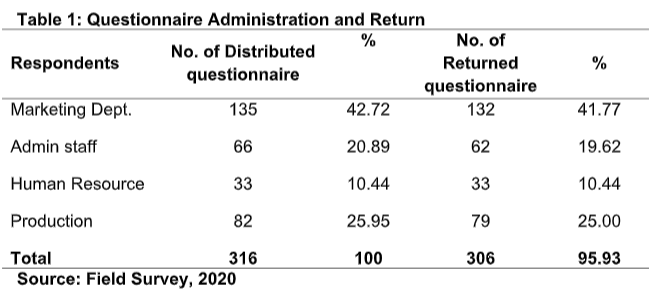
Table 1 shows the summary of questionnaire administration. Out of 316 copies of questionnaire administered to staff of Total Nig. Ltd., Port Harcourt, Rivers State, Nigeria, 306 copies were duly completed by the respondents and returned to the researcher. This showed a return rate of 95.93%. Socio-economic characteristics of the respondents Socioeconomic profile of staff of Total Nig. Ltd Port Harcourt, Rivers State
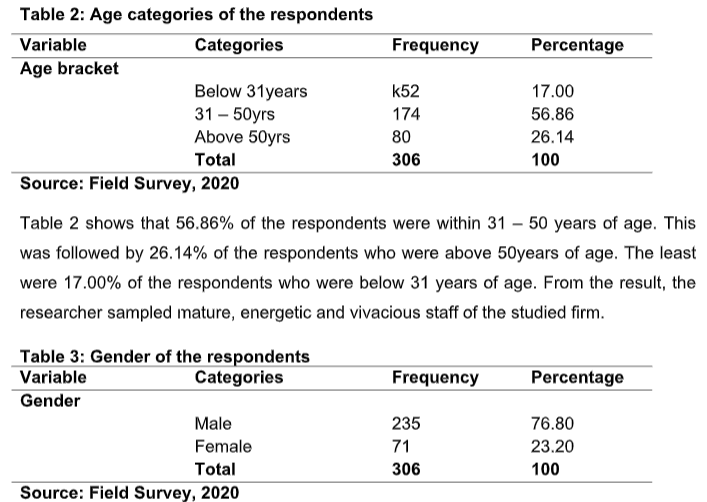
Table 2 shows that 56.86% of the respondents were within 31 – 50 years of age. This was followed by 26.14% of the respondents who were above 50years of age. The least were 17.00% of the respondents who were below 31 years of age. From the result, the researcher sampled mature, energetic and vivacious staff of the studied firm.

Source: Field Survey, 2020
From the gender category, 76.80% of the respondents were male as against 23.20% who were female. This aligned with apriori expectations, because most of the respondents were from the Marketing Unit and Production Unit of Total Nig. Ltd Port Harcourt, Rivers State which are mostly dominated by male employees. Variables Categories Frequency Percentage

Source: Field Survey, 2020
Marital status category revealed that, 87.06% of the respondents are married; while 12.94% were single. No provision was made for others because, any individual with husband or wife is married, otherwise single. The result agrees with age categories of the respondents, because most of the sampled employees are above 31years of age.

Source: Field Survey, 2020
From the educational qualifications, 83.33% of the respondents have different tertiary institutional qualifications, followed by SSCE certificate holders with only 13.73% and 2.94% just being primary school certificate holders. However, none of the respondents had no formal education. This is so because, the tasks in Total Nig. Ltd requires fluent communication outside mother tongue and practical.
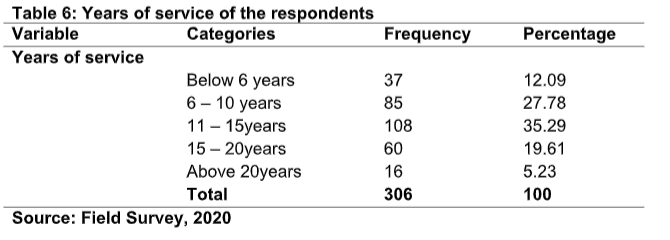
Source: Field Survey, 2020
Years of service of the respondents showed that, 35.29% have been working for Total Nig. Ltd within 11 – 15 years; followed by 27.78% and 19.61% of the respondents who have been working with the organization within 6 – 10years and 15 – 20years respectively. The least are those who had worked with the organization above 20years. This implies that, a good number of the respondents (85%) have been working with the organization for more than 5 years. Hence, the respondents have reliable information as regards motivation and its effects on employee performance in Total Nig. Ltd.
Data Presentation
Objective 1: Effect of promotion on the performance of employees of Total Nig. Ltd
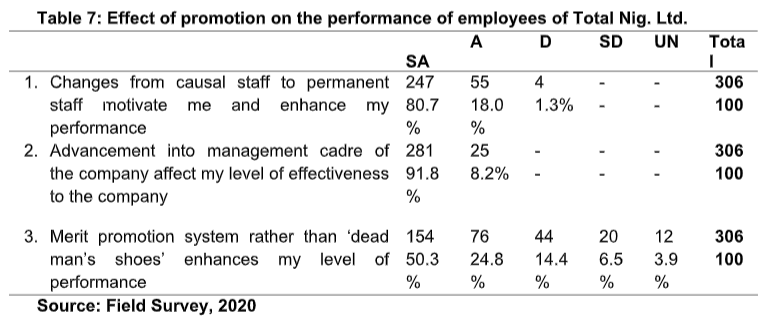
Source: Field Survey, 2020
From the Table above, 91.8% of the respondents strongly agree that advancement into management cadre of the company affects their level of effectiveness in the company. This was followed by 80.7% of the respondents who strongly agreed that prospect of change from being causal staff to permanent staff motivated them and enhanced their performance. In addition, 50.3% of the respondents also agreed that merit promotion system rather than ‘dead man’s shoes’ enhanced their level of performance. Against the majority, 14.4% of the respondents disagreed that merit promotion system rather than ‘dead man’s shoes’ enhances their level of performance. The result is in accordance with the findings of Olawumi (2013) who examined the impact of motivation on the efficiency of work performance and job satisfaction in security organizations in Oyo State. According to the findings of the study, the most valued motivational package by the employees are promotions, financial allowances, leaves, allowances for medical treatment and participation in decision making.
Objective 2: Effect of recognition on the performance of employees of Total Nig. Ltd
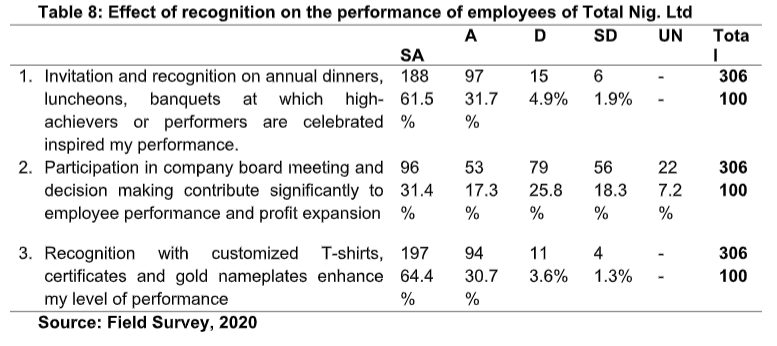
Source: Field Survey, 2020
Table 8 addressed the effect of recognition on the performance of employees of Total Nig Ltd. The result shows that 64.4% of the respondents strongly agreed that recognition with customized T-shirts, certificates and gold nameplates enhanced their level of performance. This was seconded by 61.5% of the respondents who strongly agreed that invitation and recognition on annual dinners, luncheons, banquets at which high- achievers or performers are celebrated inspired their performance. More so, 31.4% of the respondents agreed that participation in company board meeting and decision making contributed significantly to employee performance and profit expansion. Invariably, 25.8% of the respondents disagreed that participation in company board meeting and decision making contributed significantly to employee performance and profit expansion. The result is in consonance with the findings of Obikeze, (2012) who evaluated the effects of motivation on sales force performance in Guinness Nigeria Ltd. and MTN in South-East. It was disclosed that preferred participation in decision making did not have significant effect on sales force performance in Guinness Nigeria Ltd. And MTN.
Objective 3: Effect of pay raise on the performance of employees of Total Nig. Ltd
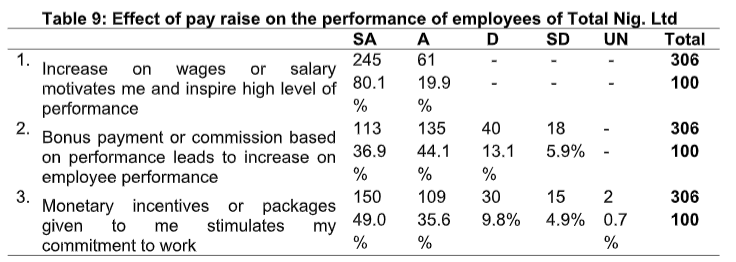
Source: Field Survey, 2020
From Table 9 above, 80.1% of the respondents strongly agreed that increase in wages/salary motivates them and inspire high level of performance. And 49.0% of the respondents strongly agreed that monetary incentives or packages given to them stimulate and increase commitment to work. More so, 44.1% of the respondents just agreed that bonus payment or commission based on performance leads to increase on employee performance. Similarly, Obikeze, (2012), found salary increase, bonus, profit sharing, wages and team-building to be strong motivational tools mostly used in manufacture and service companies.
Objective 4: Effect of compensation on the performance of employees of Total Nig. Ltd
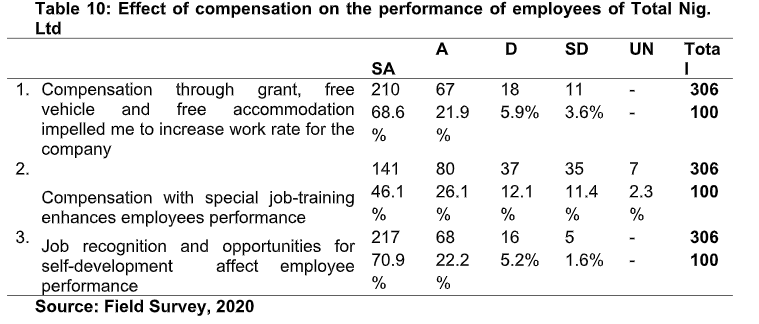
Source: Field Survey, 2020
The effect of compensation on the performance of employees of Total Nig Ltd was addressed above. The result shows that, 70.9% of the respondent strongly agreed that job recognition and opportunities for self-development affect employee performance. This was followed by 68.6% of the respondents who strongly agreed that compensation through grant, free vehicle and free accommodation influenced them to increase work rate for the company. In addition, 46.1% of the respondents agreed that, compensation with special job-training enhances employees’ performance. Inversely, 12.1% of the respondents disagreed that compensation with special job-training enhances employees’ performance.
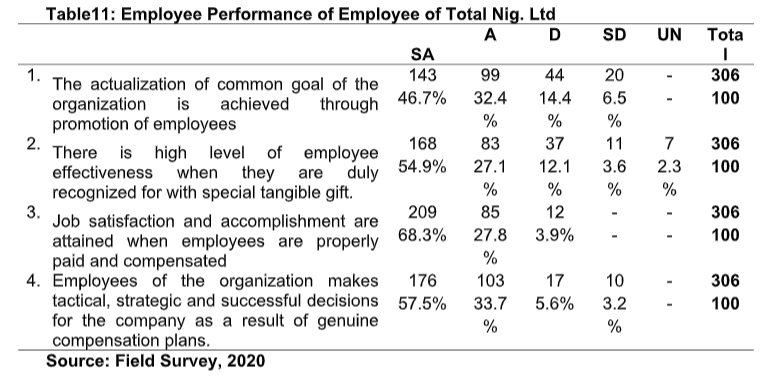
Source: Field Survey, 2020
The performance of employees of Total Nig Ltd was addressed in the Table above. The result shows that, 68.3% of the respondents strongly agreed that job satisfaction and accomplishment are attained when employees are properly paid and compensated. This was followed by 57.5% of the respondents who strongly agreed that employees of the organization make tactical and successful decisions for the company as a result of genuine compensation plans. In addition, 54.9% of the respondents agreed that, there is high level of employee effectiveness when employees’ are duly recognized for best performance with special tangible gifts. More so, 46.7% of the respondents agreed that actualization of common goals of the organization is achieved through promotion of employees. However, 14.4% of the respondent disagreed that, actualization of common goal of the organization is achieved through promotion of employees. This may be as a result of delay in promotion exhibited by some privately owned companies in Nigeria.
Test of Hypotheses
Test of Hypothesis 1: There is no significant effect of promotion on the performance of employees of Total Nig. Ltd.
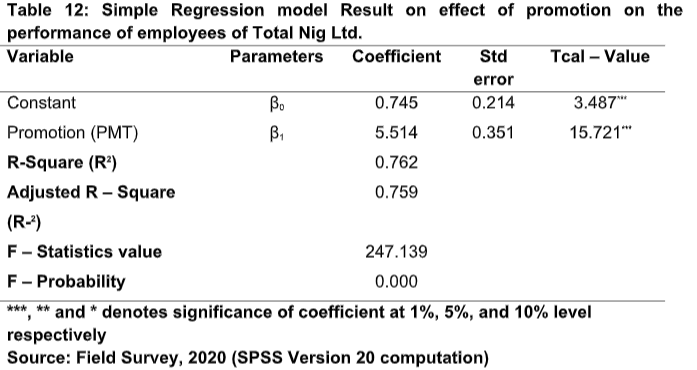
Source: Field Survey, 2020 (SPSS Version 20 computation)
From the result, promotion is statistically significant and positively related to employee performance at 1 percent level implying that, a unit increase in promotional level given to employees, leads to 5.514 units increase in performance of employee at Total Nig. Plc. Thus, employee performance in Total Nig. Ltd. is an increasing function of promotions. The coefficient of determination (R 2 ) was 0.762, indicating that 76.2% changes in dependent variable was explained by the changes in independent variables; while 23.8% was explained by the stochastic terms in model. This implies that, the independent variable (promotion) can only explain 76.2 percent of changes in employee performance in Total Nig. Ltd., leaving 23.8% percent unexplained. The F-stat value of 247.139 and t-prob value of 0.000 was observed from the analysis which is less than 0.05, indicating that the estimated regression model adopted in this study is statistically significant at 5% significant level. With this, the researcher affirmed the alternative hypothesis thus, there is a significant effect of promotion on the performance of employees of Total Nig. Ltd.
Test of Hypothesis 2: There is no significant effect of recognition on the performance of employees of Total Nig. Ltd.
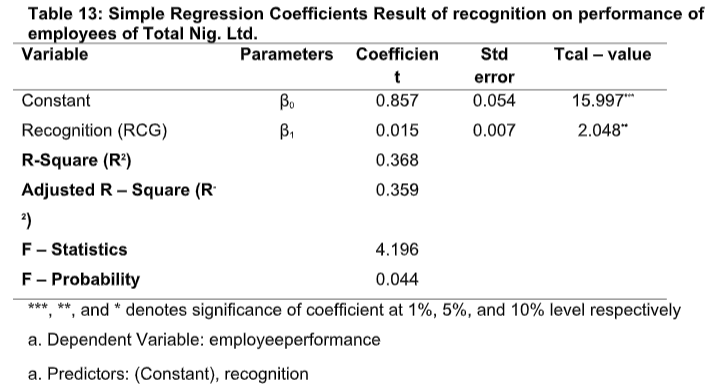
Source: Field Survey, 2020 (SPSS Version 20 computation) The coefficient of recognition (RCG) was statistically significant and positively related to performance at 5 percent level (2.048 ** ). This implies that, recognition of staff of Total Nig. Ltd., holding other variables constant, will lead to increase in their performance by 0.368 unit. In effect we upheld alternative hypothesis stating that, there are significant effects of recognition on the performance of employees of Total Nig. Ltd.
The R 2 coefficient of multiple determination was 0.368, which implies that, 36.8% variations in dependent variable was explained by changes in the independent variable, while 63.2% was unexplained by the stochastic terms in the model. Thus, the independent variable (recognition) can only explain 36.8 percent of changes in performance of employees of Total Nig. Ltd., leaving 63.2% was unexplained. The R -2 adjusted was 35.9% indicating a goodness of fit of the regression model adopted in this study which is statistically significant at 5% probability level. F-stat value of 4.196 and F-prob value of 0.044 was observed from the analysis which is less than 0.05, indicating that estimated regression model adopted in this study is statistically significant at 5% level. With this, the researcher rejected the null hypothesis and accept alternative hypothesis which states that, there are significant effect of recognition on the performance of employees of Total Nig. Ltd.
Test of Hypothesis 3: There is no significant effect of pay raise on the performance of employees of Total Nig. Ltd.
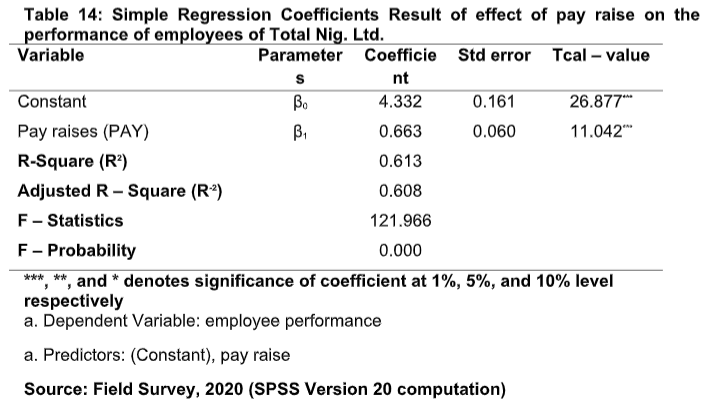
Source: Field Survey, 2020 (SPSS Version 20 computation)
The estimated value of pay raise (PAY) of 0.663 was statistically significant at 1percent level with a positive sign, implying that, raising of employee wages/salary has positive and significant effect on performance of employee in the company. Hence, we reject null hypothesis and accept alternative hypothesis which states that there are significant effect of pay raise on the performance of employees of Total Nig. Ltd. The result of coefficient of multiple determination (R 2 ) was 0.613 which implies that, 61.3% variation in the dependent variable was explained by changes in the independent Variable, while 38.7% was unexplained by the stochastic variables in the model. F-statvalue of 121.966 and F-prob value of 0.000 was observed from the analysis which is less than 0.05 (95% degree of freedom), indicating that, the estimated regression model adopted in this study was statistically significant at 5% significant level. With this, the researcher rejected null hypothesis and accepted the alternative hypothesis which states that, pay raise has significant effect on the performance of employees of Total Nig Ltd.
Test of Hypothesis 4: There is no significant effect of compensation on the performance of employees of Total Nig. Ltd.
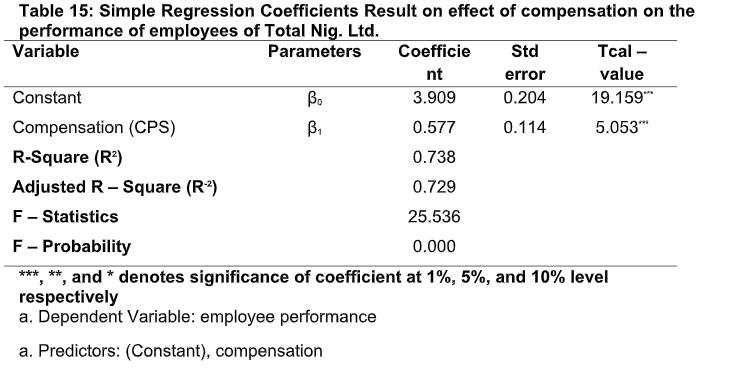
Source: Field Survey, 2020 (SPSS Version 20 computation)
The coefficient of compensation (CPS) was statistically significant and positively related to performance of employees at 1percent level. From the result, the value of compensation (CPS) of 0.577, revealed that a unit increase in compensation value, holding other variables constant, will increase performance of employees by 0.577 units. Hence, performance of employees increases as compensation increases and vice versa. Statistically, we accept alternative hypothesis which posited that, compensation has significant effect on the performance of employees of Total Nig. Ltd. The (R 2 ) coefficient of multiple determinations was 0.738 which implies that, 73.8% variation in dependent variable was explained by changes in the independent variable while 26.2% were unexplained by the stochastic variable. This implies that, the independent variable (compensation) was able to explain 73.8 percent variations in dependent variable (employee performance) while 26.2 percent was explained by the stochastic variable. F-stat value of 25.536 with F-prob. value of 0.000 which is less than 0.05 indicating goodness of fit for the regression model adopted in this study, which is statistically significant at 5% probability level. Thus, we accept the null hypothesis and reject alternative hypotheses which states that compensation has significant effect on the performance of employees of Total Nig. Ltd.
5. SUMMARY OF FINDINGS, CONCLUSION AND RECOMMENDATIONS
Summary of Findings
The study examined motivation as a tool in employees’ performance in Total Nig. Ltd. Test of hypothesis showed that there were positive and significant effects of the independent variables; promotion, recognition, pay raise and compensation on the dependent variable performance.
The hypotheses result revealed that, there are significant effects of promotion on the performance of employees of Total Nig Ltd. In line with the findings, Reena and Ahmed (2008) found a high positive correlation between promotion and employee satisfaction in service firms. This signifies that, non-financial factor such as promotion of employees is highly significant, and firms will experience high level of effectiveness and actualization of common goals when they consistently promote deserving employees. This study advocates for non-financial motivational strategies (promotion) for increased employee performance in Total Nig. Plc. There are significant effects of recognition on the performance of employees of Total Nig Ltd. The result is in line with the findings, Ude and Coker (2012) who conducted a study aim at determining the link between incentive schemes and employee motivation and productivity in organizations. The result shows that employee recognition have high significant relationship with employee motivation and productivity in both the organized private sector and public sector organizations in Nigeria. Thus, recognizing an employee inspires the confidence of an employee. Pay raise has significant effect on the performance of employees of Total Nig Ltd. And compensation has significant effect on the performance of employees of Total Nig Ltd. The result concurs with the findings of Denver, (2006) who found that bonuses and remunerations of employees play a significant role in a firm’s return on investment, sales volume and market share. There are significant effects of compensation on employee performance. This finding is in congruence with apriori expectations because compensation of employee is one of the main extrinsic motivational factors with significant impact on employee performance. This finding agrees with the work of Futrell (2002) who opined that the heart of motivation is to give employees what they really deserve from their work rate (compensation) which enhances their productivity, quality and service delivery skills. Also, Jobber (2009) agrees that motivation in terms of periodic compensation and trainings is a key for improving productivity because employees are often in the best position to think of ways to achieve their objectives more efficiently and effectively.
Conclusion
The success and the survival of any organization are determined by the way employees are remunerated and rewarded. The reward system and motivating strategies mostly determine the level of employees’ commitment and their attitude to work. However, for any organization to achieve its objective in this tensed competitive society, employers of labor must have a thorough understanding of what drives the employees to perform efficiently and reward them accordingly. Besides, employees must be motivated through adequate financial incentives plans and reward systems and this will invariably encourage them to be proactive and have right attitude to work, thereby promote organizational productivity.
Recommendations
Based on the findings and conclusion drawn in this research, the following recommendations are made:
1. That, there is need for Total Nig. Ltd. to set-up enticing motivational strategies that are geared towards facilitating and promoting appropriate service delivery and trigger effective employee performance.
2. Effective motivational schemes should be designed to include both financial and non-financial motivational packages. Hence, top management need to strategically identify the motivational incentives that lead to high performance among the employees.
3. That, a special committee be set-up to look into employees’ promotion, recognition, pay raises and compensation since they have positive and significant effects on employee performance.
4. That management must ensure that motivational packages designed / distributed to well performing employees are dynamic and constantly re-evaluated to ensure their transparency and fairness to all employees.
Suggestions for Further Studies
Research is a continuous process which calls for further studies in this area. No single research is exhaustive. Hence, it is recommended that future researchers who wish to delve into this area of study should look into the impact of intrinsic motivation on employee effectiveness. In further studies, training should be captured as one of the objective variables.
Limitations
A major limitation of this study is that the researcher was not able to generate samples from employees of Total Nig. Ltd. all over Nigeria due to time and financial constraints. The sample size is small because “the larger the sample the more representative the study becomes” (Anyanwu, 2016).
Bibliography (standard format of citations according to international standards):
Aamir, A., Jehanzeb, K., Rasheed, A. & Malik, O.M. (2012). Compensation methodsand employees motivation (with reference to employees of National Commercial Bank Riyadh). https://www.researchgate.net/publication/235644097
Ajila, C., & Abiola, A. (2004). Influence of Rewards on Workers Performance in an Organization. Journal of Social Science, 8(1), 7-12.
Amoatemaa, A. S. & Kyeremeh, D. D. (2016). Making employee recognition a tool for achieving improved performance: Implication for Ghanaian Universities. Journal of Education and Practice, 7(34).
Anyanwu, U. (2002). Productivity and capacity building. Proceedings of the 9th Annual Conference of the Zonal Research Units, Gateway Hotel, Abeokuta
Armstrong M., & Murlis, H. (2004). Reward management: a handbook of remuneration strategy and practice. London: Kogan Page Armstrong, M (2001). Handbook of human resource management. 8 th (ed) London: Kogan Page.
Ayam J., Kusi-Appiah, G., Nyamekye, T. A., Kyei-Addae, A. Amoah, A. (2012).
Effects of motivation on employees’ performance at First Allied Savings and Loans Limited, Adum Branch –Kumasi. A dissertation submitted to the Department f Business Studies, Christian Service University College.
Bao, C Nizam, I. (2015). The impact of motivation on employee performance in the electronics industry in China. International Journal of Accounting Business Management (IJABM), 3(2). https://www.researchgate.net/publication/316549652
Bernardin, H. J. (2007). Human resource management: an experiential approach. Tata: McGraw-Hill Publishers.
Brun, J. P., & Dugas, N. (2008). An analysis of employee recognition: Perspectives on human resources practices. The International Journal of Human Resource anagement, 19(4), 716‐ 730.
Carraher, S. M., Gibson, J. W. & Buckley, M. R. (2006). Compensation satisfaction inthe Baltics and the USA. Baltic Journal of Management, 1(1).
https://www.emerald.com/insight/content/doi/10.1108/17465260610640840/full/html
Chien-Chung, L. (2003). Explorations in achievement motivation, presented at Annual Meeting of the American Psychological Association, Washington, DC
Cole, M. (1998). Cultural psychology: A once and future discipline. Cambridge, MA: Harvard University Press.
Danish, R.Q., Usman, A. (2010). Impact of reward and recognition on job satisfaction and motivation: An empirical study from Pakistan. International Journal of Business and Management, 5(2): 159 Denver Severt,D., Wang, Y., Chen,P. Breiter,D. (2006). Examining the motivation, perceived performance, and behavioral intentions of convention attendees: Evidence from a regional conference. Tourism Management, 28 (1), 399–408.
https://www.researchgate.net/publication/223077809
Dessler, G. (2000). Human resource management (8 th ed.). New Jersey: Pearson Education, Inc.
Dobre, O-I (2013). Employee motivation and organizational performance. Review of Applied Socio- Economic Research, 5(1), 53-67
Ekundayo, O. A. (2018). The impact of motivation on employee performance in selected insurance companies in Nigeria
Eshun. C. & Frank K. Duah, F. K. (2011). Rewards as a motivation tool for employee performance. MBA School of Management
Futrell, A. B. (2002). The motivation to work. New York: John Wiley.
Grote, D. (2006). Discipline without punishment: The proven strategy that turns problem employees into superior. USA; AMACOM
Haque, M. F., Haque, M. A. & Islam, S.(2014). Motivational theories – A critical analysis. ASA University Review, 8(1).
https://www.researchgate.net/publication/306255973
Harrison, K. (2005). Why Employee Recognition is so important. Retrieved from www.cuttingedgepr.com
Higgins, J. M. (1994). The management challenge (2nd ed.). New York: Macmillan Igbal, Ahmad, Haider, Batool & Qurat-ul-ain, (2013). Iqbal, N., Ahmad, N., Haider, Z, Batool, Y. Qurat-al-ain (2013). Impact of performance appraisal on employee performance involving the moderating role of motivation. Arabian journal of Business and Management Review 3 (1).
Imran, A., Ahmad S., Nisar, Q. A. Ahmad, U. (2014). Exploring Relationship among Rewards, Recognition and Employees’ Job Satisfaction: A Descriptive Study on Libraries in Pakistan. Middle-East Journal of Scientific Research, 21 (9): 1533-1540
Ivancevich, J., & Matteson M. T. (1998). Organizational behavior and management. 5th ed. New York: McGraw-Hill.
Jane M. N., Mike E. I, Namusonge G.S. (2012). Determinants of Academic Staff Retention in Public Universities in Kenya: Empirical Review. International Journal of Humanities and Social Science, 2 (13)
Jobber, H. L. (2009). The social psychology of organization and employee management. 2nd Ed., New York, McGraw Hill.
Kane, J.S. (1996). The conceptualization and representation of total performance effectiveness. Human Resource Management Review, 6 (1)123-145.
Kian, T. S., Yusoff, W. F. W. (2014). Motivation and promotion opportunity of academic citizens towards open innovation: Proposed model.
https://www.researchgate.net/publication/282972751
Koontz, H. (1990). Essentials of management. New York, NY: The Free Press
Kreitner, R. (1989). Management (4th ed.). Boston, MA: Houghton Mifflin
Lindner, J. R. (1998). Understanding employee motivation. Journal of Extension, 36(3), 1-8.
Luthans, F., & Stajkovic, A. (2000). The impact of recognition on employee performance.
http://www.sba.muohio.edu/management/MWAcademy/2000/,
Luthans, K. (2000). Recognition: A powerful but often overlooked leadership tool to improve employee performance. Journal of Leadership Studies,7(1).
Mathias, R.L and Jackson, J.H. (2000), Human Resource Management, 9th Edition, Cincinnati.South –Western College Publishing
Mile, E. (2004) in Ekundayo, O. A. (2018). The impact of motivation on employee performance in selected insurance companies in Nigeria
Mohamud,S. A., Ibrahim, A. A. & Hussein, J. M. (2017). The effect of motivation on employee performance: Case study in Hormuud Company in Mogadishu Somalia.
International Journal of Development Research, 7(11), 17009-17016.
https://www.researchgate.net/publication/321869461
Muogbo, U. S. (2013). The Influence of motivation on employees’ performance: A study of some selected firms in Anambra State. An International Journal of Arts and
Humanities, 2 (3), 134-151 Nduka, O. (2016). Employee motivation and performance thesis. Centria University of Applied Sciences Business Management
Nolan, S. (2012). A Look of Current Trends Data. Strategic HR Review, 11(3), 32-54.
Nyakundi, W. K., Karanja, K., Charles, M., & Bisobori, W.N. (2012). Enhancing the role of employee recognition towards improving performance: A survey of Keyatta
National Hospital Kenya. International Journal of Arts and Commerce, 1 (7).
Obikeze, A. C. (2012). Effect of motivation on sales force performance in Guinness
Nigeria Plc and MTN in South - East, Nigeria. Journal of Advertising and Communication, 10 (6), 34 – 52.
Olawumi, Y. I. (2013). Impact of motivation on the efficiency of work performance and job satisfaction in security organizations in Oyo State. Journal of Business
Administration and Communication, 77 (45), 10 – 23. Penney, L. M., David, E. & Witt, L.A. (2011).A review of personality and performance:
Identifying boundaries, contingencies, and future research directions. Human Resource Management Review, 21(1), 297–310
Perry, J. L., Mesch, D., & Paarlberg, L. (2006). Motivating Employees in a New Governance Era: The Performance Paradigm Revisited. Public Administration Review, 66(4), 505–514.
Reena, S. T. & Ahmed, B. M. (2008). The relationship between motivational strategies and employee satisfaction in service firms. Journal of Economic Research and
Development, 21 (19) 47 – 59. Richard, B. (2014). The effect of motivation on employees’ performance: Empirical evidence from the Brong Ahafo Education Directorate. A thesis submitted to the
Department of Managerial Science, Kwame Nkrumah University of Science and Technology
Roberts, R.L. (2005).The relationship between rewards, recognition and motivation at an Insurance Company in the Western Cape. A thesis submitted in the Department of Industrial Psychology at the University of the Western Cape
Robescu, O. & Iancu, A-G. (2016). The effects of motivation on employees performance in organizations. Valahian Journal of Economic Studies.
Roszyk-Kowalska, G. & Duda, M. (2017). Promotion as a motivational tool based on the example of Antonin Forest Inspectorate.
https://www.researchgate.net/publication/321316140
Shahzadi, I., Javed, A., Pirzada, S. S., Nasreen, S., & Khanam, F. (2014). Impact of employee motivation on employee performance. European Journal of Business and Management,6 (23), 159-166.
Stajkovic, A. D. & Luthans, F (2003). Behavioural and task performance in organizations: Conceptual background, meta-analysis and test of alternative models. Personal Psychology 56 (1), 155-194
Sudiardhita K. I. R., Mukhtar, S., Hartono, B., Herlitah, E., Sariwulan, T.Nikensari, S. I. (2018).The effect of compensation, motivation of employee and work satisfaction to employee performance. Academy of Strategic Management Journal, 17(4) Tršková, K. (2016). Motivation, performance and efficiency.
https://www.researchgate.net/publication/29176557
Ude, U. F. & Coker, L. (2012). The link between incentive schemes and employeemotivation and productivity in organizations (A study of private sector and public sector organizations in Nigeria). IITM Journal of Business Studies (JBS), 4(1); 39- 51.
Vroom V,. (1964). Work and Motivation. Malabar, Florida: Robert E. Krieger Publishing Company
Waiyaki, E. W.(2017). Effect of motivation on employee performance: A case of Pam Golding Properties Limited, Nairobi. A masters research project report submitted to the Chandaria School of Business. United States International University Africa
Yavuz, N. (2004). The use of non-monetary incentives as a motivational tool: A survey study in a Public Organization in Turkey
https://www.researchgate.net/publication/40540143
Author : Rita LELEH, student of LIGS University